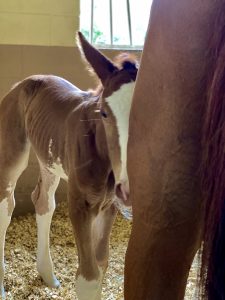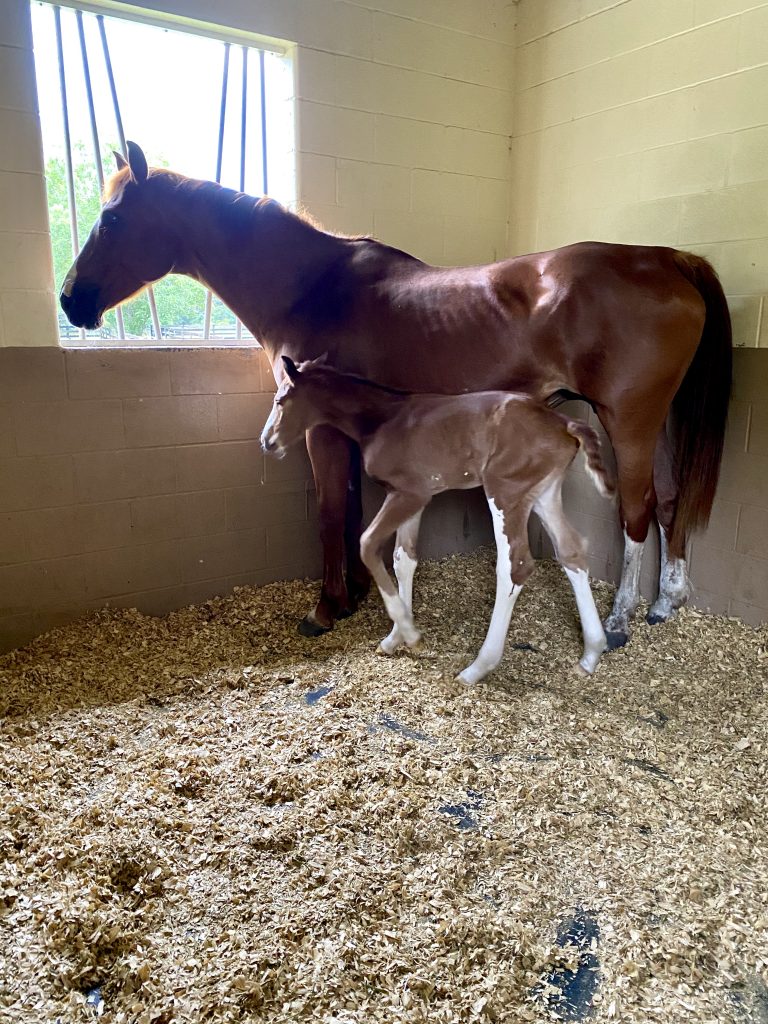Tuesdays with Tony
Everyone loves the pitter patter of little feet. Everyone but me, that is! In case you all missed it, this weekend on Saturday night, we welcomed a new life into the world here at the clinic, and let me tell you, it was a huge inconvenience to me. It interrupted my sleeping pattern and my minions didn’t even let me out to assist. It was like I didn’t even exist and all that mattered was the new baby, what the heck? In fact, come to think of it, all last week they spent more time staring at the mare than me. What gives? Needless to say, Monday morning, I had a chat with my staff about this oversight. During our chat, the docs explained why it was so important to watch mom so carefully and what all went into Saturday night. Instead of continuing to be bitter about the lack of attention I have been receiving, I have decided to share my newfound knowledge with you all.
Foal Watch
Early last week, the mare was dropped off at the clinic for what they call foal watch. I was very confused by this since there was a full-grown adult horse at the clinic, not a foal, so how was I supposed to watch the foal? My minions explained that foal watch is actually, watching the mare when she is getting close to having the foal. Still not 100% sure what all is involved in foal watch, I allowed the docs to explain further. They explained that during foal watch they monitor the mare’s behavior, her eating habits, changes to her body and any other differences to her normal routine.
The mare’s gluteal muscles will become very soft when the she is close to foaling and her tail will also become more relaxed. The docs explained that from the first night that the mare arrived, they monitored the stall cameras every hour for signs of labor. Twice a day, they would check her udder and milk development. Part of this involves checking the pH of her milk. Once her pH drops below 7, and more specifically 6.8, it’s go time, and the mare will likely foal in the next 24 hours.
This is exactly what happened on Saturday. Saturday morning at her pH check, her milk was around 7.25 and by 5pm it had dropped to 7. That’s when my docs knew it was probably going to happen. I sure wish they would have warned me, so I could have taken some extra naps in preparation for a long night!
Labor
There are three stages to labor which apparently can last for many days prior to actually having a foal on the ground. The first stage of labor is the longest, and it involves the positioning of the baby. This is when the mare may show signs similar to those of colic. She may go off her feed intermittently. Often times, the mare may be seen rolling, pawing and frequently kicking at her abdomen. Usually these signs will diminish, the mare will return to normal, and it will be very confusing to those who are waiting for the foal to come.
The second and third stages of labor should be relatively short. The second stage of labor starts when the mare’s water breaks and the foal is expelled. Abdominal contractions are visual followed by periods of rest. My docs explained that it is extremely important to monitor this stage of labor. This is when things can go very wrong, very quickly. The foal should be presenting front feet first, followed shortly by a nose. The foal should be expelled within 30 minutes, 45 minutes maximum.
If the foal does not present front feet and head first, or takes longer than 45 minutes to come out, it is considered an emergency and involves intervention from the docs. This incorrect positioning resulting in a difficult birth is called a dystocia, and dystocia can be life-threatening to the mare and foal. Luckily, everything went smooth on Saturday and the foal was expelled within 30 minutes.
The final stage of labor is the expulsion of the fetal membranes, or placenta. After the foal is born, the mare will continue to contract to facilitate the expulsion of the placenta. The placenta should be passed completely within 3 hours after the foal is expelled. Once again, it is considered an emergency and can be life threatening if the placenta is not passed or if a piece of it is retained.
1-2-3 Rule
After the foal was born, I was super excited that I was about to get some sleep again, but I couldn’t get the docs to leave. How inconsiderate of them! They said they had to stay and monitor the baby, and make sure that he was able to stand on his own, move around, and nurse. The rule is, after the baby is born it should be standing within an hour. After 2 hours, the baby should have nursed, it is essential that the baby nurse within this time so that it ingests colostrum and is protected against disease and infection. If the foal doesn’t nurse within 2 hours of birth, doctor intervention may be necessary. They may need to milk the colostrum from the mare and tube the foal or offer a bottle.
As I previously mentioned, the placenta must be passed within 3 hours after birth, and is thus the 3 in the 1-2-3 rule. I realize now why my docs were at my clinic for so long after the foal was born. They had to wait for the mare and foal to reach all these milestones before they felt comfortable leaving them for a few hours.
New Foal Exam
Despite being present for hours over night Saturday night, they showed back up on Sunday. And I thought, finally, I am going to get some attention, maybe some belly rubs or extra snacks. Alas, I found myself disappointed. Yet again it was all about the baby. Sure, he’s kind of cute, but I’m a pretty cute cat and could use a little attention as well. At least this time they let me out to explore the new baby.
While I was out performing my “Cat” scan, Dr. Lacher was also performing her new foal exam. She was checking him for any physical problems. She listened to his heart, lungs and gut sounds. She checked eyes, joints, mouth, and umbilicus. She also pulled blood to assess his IgG. The results of this blood test will tell us if the foal got enough colostrum. If the results of the test were low, it would mean the foal may need to have a plasma transfusion and/or be started on antibiotics. Dr. Lacher finished her new foal exam with some scratches for the new baby, and FINALLY, I got my rubs and scratches.
Despite the lack of attention I received this past weekend, it was pretty neat to learn about all that goes into getting a healthy new foal on that ground. If you’re expecting a little one soon, or think you might want to expect one in the future, be sure to talk with my docs about your mare’s birthing plan and what to watch for when your new foal is due.
Until next week,
~Tony
P.S. If you want to know more, my docs have several podcasts on this topic. You can find them here on the Podcast Page, or you can subscribe to Straight form the Horse Doctor’s Mouth wherever you get your podcasts.
Tuesdays with Tony is the official blog of Tony the Clinic Cat at Springhill Equine Veterinary Clinic in Newberry, Florida. If you liked this blog, please subscribe below, and share it with your friends on social media! For more information, please call us at (352) 472-1620, visit our website at SpringhillEquine.com, or follow us on Facebook!
[jetpack_subscription_form title="Subscribe to Whinny's Wisdoms"]



